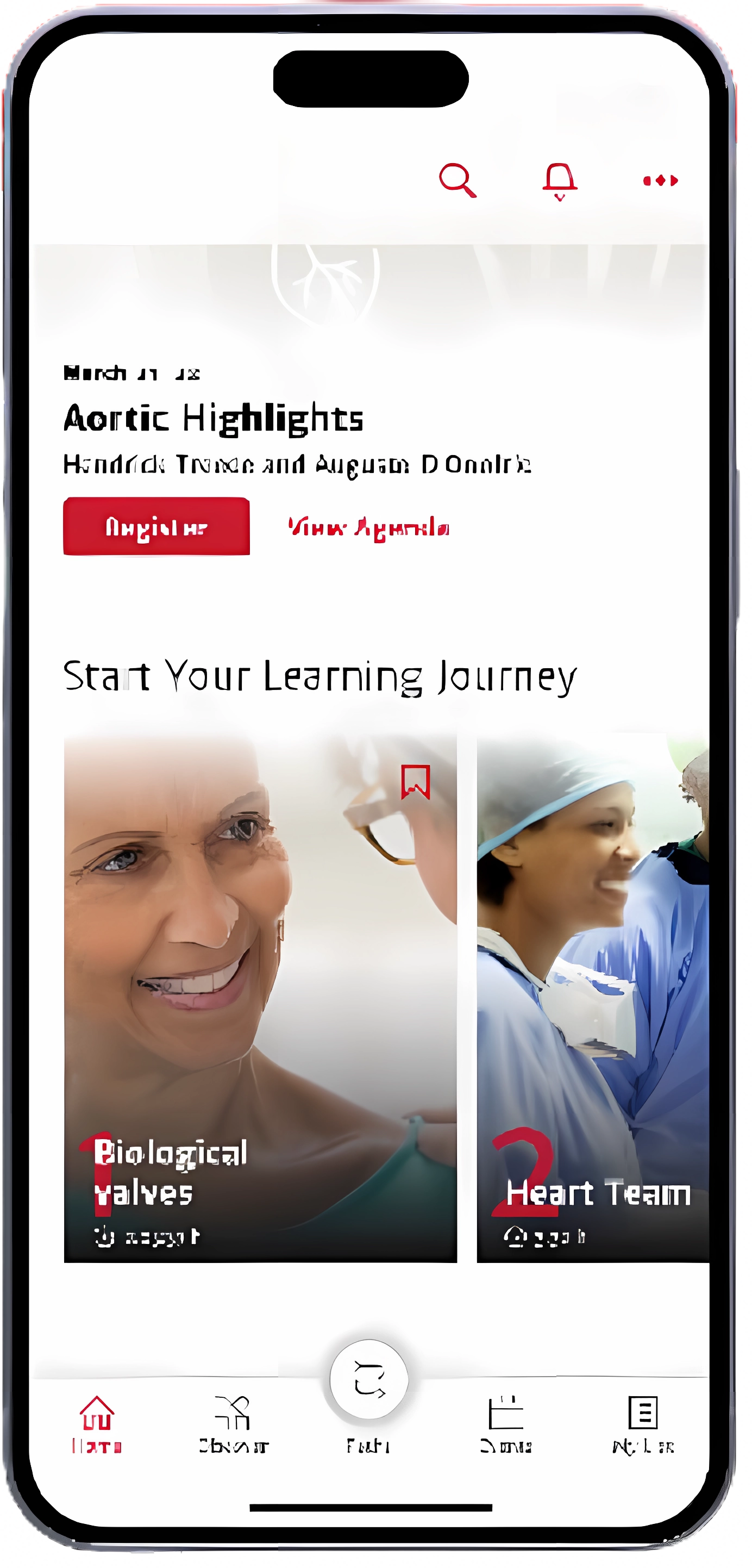Five years hemodynamic performance of three aortic bioprostheses. A randomized clinical trial
December 8, 2022
Montero Cruces L, Carnero Alcázar M, Perez Camargo D, Cobiella Carnicer J, Campelos Fernandez P, Reguillo Lacruz FJ and Maroto Castellanos LC.
Presented at 36th European Association for Cardio-Thoracic Surgery Annual Meeting, 2022.
Key points:
- In the BEST-VALVE randomised clinical trial, the Carpentier-Edwards PERIMOUNT Magna Ease valve achieved the best haemodynamic performance 5 years after surgery, compared with the Crown PRT and Trifecta valves.
Background information
- The PERIMOUNT Magna Ease, Crown PRT and Trifecta pericardial valves are used worldwide in aortic valve replacement surgery.
- High-quality data comparing the haemodynamic performance of the three bioprostheses are sparse.
Aims
- To compare the medium-term haemodynamic performance of the PERIMOUNT Magna Ease, Crown PRT and Trifecta biprostheses.
Type of study
- Longitudinal, single-centre, observer-blind, randomised Phase IV study. (European database of clinical trials: 2018-001658-57.)
Endpoints
- The primary endpoint was the haemodynamic performance (mean and peak aortic gradients, peak aortic velocity and effective orifice area) 5 years post-surgery.
- Secondary endpoints included overall survival and survival free of reoperation, acute myocardial infarction, thromboembolism, stroke or endocarditis.
Methods
- The BEST-VALVE independent clinical trial enrolled patients who underwent aortic valve replacement surgery between 2014 and 2017.
- Patients were randomly assigned to receive either a PERIMOUNT Magna Ease, Crown PRT or Trifecta valve (1:1:1).
- Haemodynamic performance was assessed through echocardiographic examination.
Results
Study population
- The study included 154 patients (PERIMOUNT Magna Ease valve: n=48; Crown PRT valve: n=51; Trifecta valve: n=55).with a mean age of 76.5 (inter-quartile range [IQR] 71.5–79.5) years, 59.7% of patients were male and the average EuroSCORE II was 2.3 (IQR 1.4–4).
- Elective procedures made up 8% of procedures and 87.7% of patients had severe aortic stenosis.
Haemodynamic performance 5 years after surgery
- Patients who received PERIMOUNT Magna Ease valve had the best haemodynamic outcomes (Table 1).
Serious adverse events
- Five years after surgery, serious adverse event rates were similar for all three study devices.
- The only exception was structural valve deterioration (SVD), which occurred significantly more often among patients with Trifecta valve (10.9%) compared with Crown PRT (3.9%) and Magna Ease (0%, p=0.04). (Table 2).
Surgical
- Overall and event-free survival were similar across all three study groups.
Table 1. Echocardiography outcomes 5 years after surgery.

Table 2. Serious adverse events at 5 years after surgery.

Conclusion
After 5 years’ follow-up, the PERIMOUNT Magna Ease valve showed the best haemodynamic performance among the three study devices. Clinical outcomes were similar across cohorts.
Due to the small sample site and short duration of follow-up, the results of this study should be interpreted with caution.
This document is a summary of the Montero Cruces L et al. presentation, as presented at the EACTS congress, and covers key information including aim, type of study, methods, results, limitations and conclusions.
The full publication is available at:
Abbreviations:
Medical device for professional use. For a listing of indications, contraindications, precautions, warnings, and potential adverse events, please refer to the Instructions for Use (consult eifu.edwards.com where applicable).
Edwards, Edwards Lifesciences, the stylized E logo, Carpentier-Edwards, Carpentier-Edwards PERIMOUNT, Carpentier-Edwards PERIMOUNT Magna Ease, Magna, Magna Ease, PERI, PERIMOUNT and PERIMOUNT Magna are trademarks or service marks of Edwards Lifesciences Corporation. All other trademarks are the property of their respective owners.
© 2022 Edwards Lifesciences Corporation. All rights reserved. PP–EU-5311 v1.0
Edwards Lifesciences • Route de l’Etraz 70, 1260 Nyon, Switzerland • edwards.com
Meuris B, Senage T, Borger M, Siepe M, Stefano P, Laufer G, Langanay T and De Paulis R, on behalf of the INDURE investigators
Presented at 36th European Association for Cardio-Thoracic Surgery Annual Meeting, 2022.
Key points:
- One-year clinical outcomes of patients aged ≤60 years within the INDURE registry were excellent, with few cardiovascular events and satisfactory valve performance
- Patients achieved a general population standard quality of life (QoL) within 3–6 months post surgery
Background information
- The treatment of comparatively young patients with implantation of surgical aortic bioprosthetic valves has raised questions about valve durability and longetivity.1
- The INSPIRIS RESILIA Durability Registry (INDURE) was designed to assess the performance of the INSPIRIS RESILIA bioprosthetic valve in patients aged 60 years or younger.1
Aims
- To evaluate the clinical and QoL outcomes of the INSPIRIS RESILIA valve in patients aged ≤60 years 1 year after surgical aortic valve replacement (SAVR).
Type of study
- A prospective, open-label, multicentre registry study.
Endpoints
Endpoints included time-related valve safety according to VARC-2 guidelines and haemodynamic performance at 1 year and changes in QoL from baseline to 1 year.
- Follow-up included Clinical Events Committee adjudication and CoreLab echocardiography adjudication at 1, 3 and 5 years.
Methods
- The study included patients aged 18–60 years undergoing SAVR.
- Patients were followed-up with echocardiography after 1 year.
- QoL was assessed using the Kansas City Cardiomyopathy Questionnaire (KCCQ) and the Short Form 12 item (version 2) Health Survey (SF12v2).
Results
Patients
- The 1-year analysis included 421 patients from 21 centres across Europe and Canada, with a mean age of 53.5 ± 6.9 years, of whom 23.5% were female. Mean body surface area was 2.00 ± 0.23 m2. Mean EuroSCORE II was 1.5 ± 1.6% and 27.2% of patients were in NYHA class III/IV.
- The mean follow-up was 7 ± 2.3 months.
- Despite being of similar age to males, female patients had reduced body surface area (p<0.001), increased EuroSCORE II (p<0.001), as well as increased incidence of NYHA class III or IV (p<0.001) and chronic obstructive pulmonary disease (p=0.005).
Clinical outcomes
- Clinical outcomes were excellent (Table 1), with a hospital mortality that was better than predicted (0.7% vs 1.5%).
- Haemodynamic performance was satisfactory and stable throughout follow-up (mean pressure gradient at discharge was 7 ± 4.3 mmHg, and 12.6 ± 5.3 mmHg at one year).
- No cases of structural valve deterioration (SVD) were recorded.
Table 1. Safety outcomes early and between 31 days and 1 year after surgery
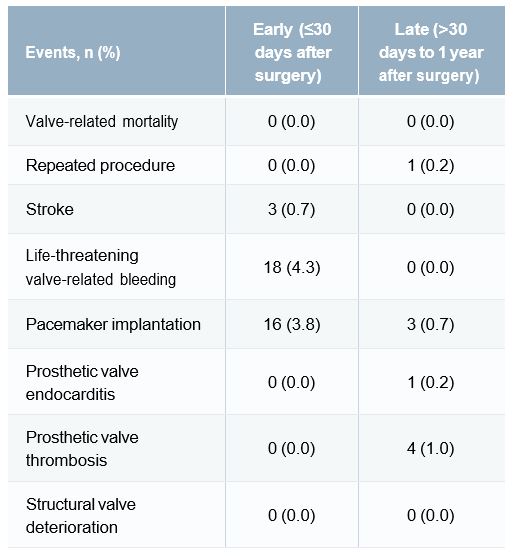
QoL
- Within 3–6 months, QoL was restored to good-to-excellent on the KCCQ scale (score between 75–100) and approximately matching the QoL of the general US population according to the SF12v2 scoring system (approximate score of 50).
- Female patients had generally significantly lower scores than men.
Conclusion
One-year clinical outcomes of patients aged ≤60 years within the INDURE registry were excellent, with stable performance, better-than-predicted hospital mortality, low incidence of cardiovascular events, only four incidences of valve thrombosis (which did not require intervention), and no SVD events. Patients returned to expected QoL within 3–6 months after surgery. Notably, female patients tended to have a higher NYHA functional class at the time of surgery and had consistently lower QoL scores than males. Longer follow-up is underway.
References
- Meuris B, Borger MA, Bourguignon T et al. Durability of bioprosthetic aortic valves in patients under the age of 60 years – rationale and design of the international INDURE registry. J Cardiothorac Surg. 2020; 15: 119.
This document is a summary of the Meuris B et al. presentation and covers key information including aim, type of study, methods, results and conclusions.
The full publication is available at:
Abbreviations:
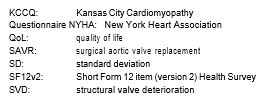
No clinical data are available that evaluate the long-term impact of RESILIA tissue in patients.
Medical device for professional use. For a listing of indications, contraindications, precautions, warnings, and potential adverse events, please refer to the Instructions for Use (consult eifu.edwards.com where applicable).
Edwards, Edwards Lifesciences, the stylized E logo, INSPIRIS, INSPIRIS RESILIA, and RESILIA are trademarks or service marks of Edwards Lifesciences Corporation. All other trademarks are the property of their respective owners.
© 2022 Edwards Lifesciences Corporation. All rights reserved. PP–EU-5306 v1.0
Edwards Lifesciences • Route de l’Etraz 70, 1260 Nyon, Switzerland • edwards.com
Georges G, Bernard J, Pibarot P, Kalavrouziotis D and Mohammadi S.
Presented at 36th European Association for Cardio-Thoracic Surgery Annual Meeting, 2022.
Key points
- The INSPIRIS RESILIA valve showed comparable early and mid-term outcomes in patients who underwent surgical aortic valve replacement (SAVR), to the Carpentier-Edwards PERIMOUNT Magna Ease valve.
- The INSPIRIS RESILIA valve facilitated significantly lower mean pressure gradients at discharge, 1–3 months and 2 years compared with the Carpentier-Edwards PERIMOUNT Magna Ease valve.
Background information
- The number of younger patients receiving aortic bioprostheses is rising, creating a need for devices with better haemodynamic performance and durability.
- The INSPIRIS RESILIA valve is a relatively new device, for which only limited data are available currently.
Aims
- To evaluate the real-world mid-term clinical and echocardiographic outcomes in patients with INSPIRIS RESILIA valve.
Type of study
- A single-centre, retrospective registry study.
Endpoints
- Endpoints included haemodynamic outcomes, survival, and incidence of structural valve deterioration (SVD).
Methods
- The study included adults who underwent SAVR with an INSPIRIS RESILIA valve or a PERIMOUNT Magna Ease valve between January 2018 and July 2021 with ≥1 postoperative echocardiography examination.
- To account for baseline differences, patients were propensity score-matched for age, sex, prosthesis size, body surface area, body mass index and left ventricular ejection fraction.
Results
Patients
- The study originally enrolled 953 patients, 434 of whom were included in the propensity score-matched cohort (Table 1).
- The study achieved complete clinical follow-up (100%; median follow-up time: 2.5 years).
Table 1. Baseline characteristics of the propensity score-matched population.

Table 2. Post-operative adverse events and complications for the propensity score-matched cohort
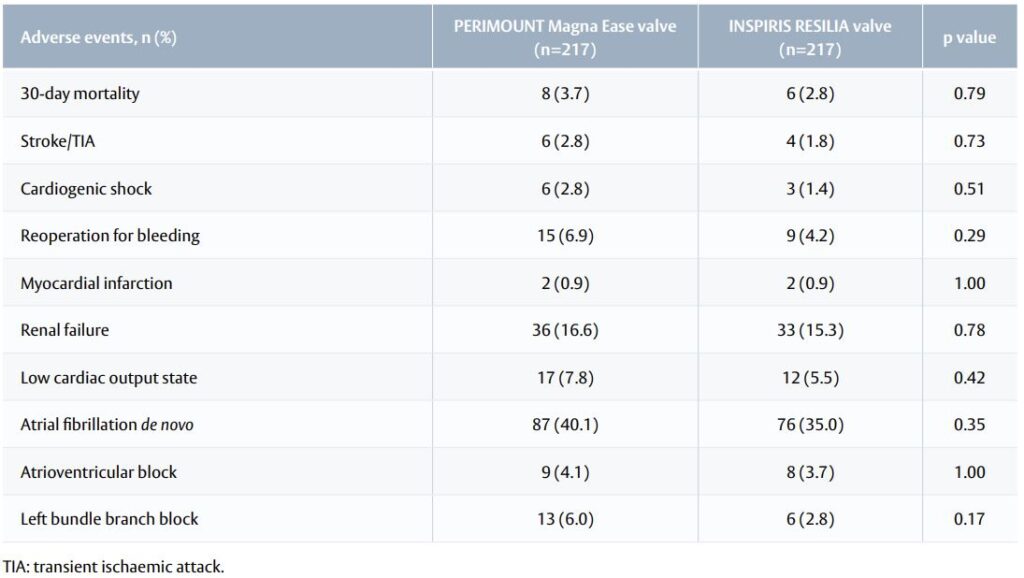
Clinical outcomes
- Early post-operative outcomes were similar between groups (Table 2).
- Survival was not significantly different between groups throughout follow-up (p=0.89).
- Readmission for cardiovascular events or stroke was more frequent among patients with PERIMOUNT Magna Ease valve (proportion of patients with readmission after 30 months: 6% with INSPIRIS RESILIA valve, 14% with PERIMOUNT Magna Ease valve; p=0.01).
- SVD was rare, with only two moderate SVD cases by Year 2 (both in the 21-mm INSPIRIS RESILIA valve group; p=0.87).
Haemodynamic outcomes
- The INSPIRIS RESILIA valve showed significantly lower mean pressure gradients at discharge, at 1–3 months and 2 years versus the PERIMOUNT Magna Ease valve (Figure 1).
Figure 1. Mean pressure gradient over time (propensity score-matched cohort).
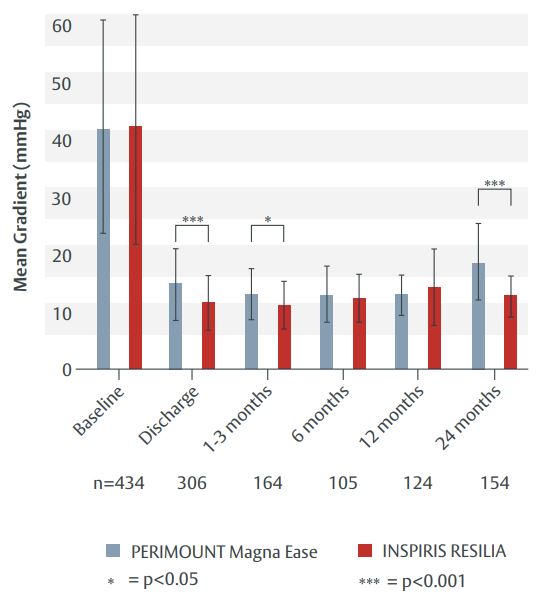
Conclusion
The post-operative and mid-term outcomes were comparable in both study groups. The INSPIRIS RESILIA aortic valve showed stable mid-term haemodynamic performance, with a mean pressure gradient at 2 years that was significantly lower than with the PERIMOUNT Magna Ease valve. Long-term follow-up is underway.
This document is a summary of the Georges G et al. presentation as presented at the EACTS congress, and covers key information including aim, type of study, methods, results and conclusions.
The full publication is available at:
Abbreviations:
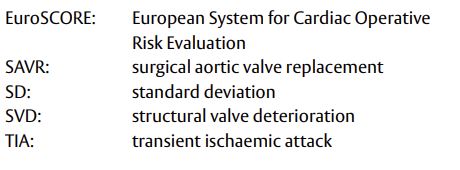
No clinical data are available that evaluate the long term impact of RESILIA tissue in patients.
Medical device for professional use. For a listing of indications, contraindications, precautions, warnings, and potential adverse events, please refer to the Instructions for Use (consult eifu.edwards.com where applicable).
Edwards, Edwards Lifesciences, the stylized E logo, Carpentier-Edwards, Carpentier-Edwards PERIMOUNT, Carpentier-Edwards PERIMOUNT Magna Ease, INSPIRIS, INSPIRIS RESILIA, Magna, Magna Ease, PERI, PERIMOUNT, PERIMOUNT Magna and RESILIA are trademarks or service marks of Edwards Lifesciences Corporation. All other trademarks are the property of their respective owners.
© 2022 Edwards Lifesciences Corporation. All rights reserved. PP–EU-5307 v1.0
Edwards Lifesciences • Route de l’Etraz 70, 1260 Nyon, Switzerland • edwards.com
Francica A, Tonelli F, San Biagio L, Rossetti C, Tropea I, Luciani GB, Faggian G and Onorati F.
Presented at 36th European Association for Cardio-Thoracic Surgery Annual Meeting, 2022.
Key points:
- The safety and efficacy outcomes of the new INSPIRIS RESILIA valve in patients younger than 70 years were comparable to the established Carpentier-Edwards PERIMOUNT Magna Ease valve at mid-term.
- At Year 3, haemodynamic outcomes remained stable and were similar between INSPIRIS RESILIA valve and the comparator.
Background information
- The third-generation PERIMOUNT Magna Ease valve is the gold standard bioprosthesis for patients of all ages.
- The INSPIRIS RESILIA valve is a new bovine pericardial valve, and data on its use in patients aged ≤70 years are currently limited.
Aims
- To compare the haemodynamic performance of the INSPIRIS RESILIA valve vs the PERIMOUNT Magna Ease valve in aortic position in patients younger than 70 years who had undergone aortic valve replacement surgery.
Type of study
- A propensity score-matched analysis.
Endpoints
- The endpoint was haemodynamic performance, including mean pressure gradient, peak velocity (Vmax) and the left ventricular end-diastolic volume (LVEDV) at Year 1.
Methods
- The study included patients aged <70 years who received an INSPIRIS RESILIA valve between 2017 and 2022 or a PERIMOUNT Magna Ease valve between 2010 and 2012.
- Propensity score-matching was used to account for differences in baseline characteristics, including age, diabetes, hypertension, dyslipidaemia, atrial fibrillation, bicuspid valve and moderate–severe aortic regurgitation.
- Patients underwent follow-up examination with echocardiography 1 year after surgery.
Results
Patients
- The study included 238 patients with PERIMOUNT Magna Ease valve and 192 with INSPIRIS RESILIA valve; 122 of each group were included in the propensity score-matched analysis.
- In the propensity-matched cohort, the mean age was 7 ± 11.1 years in the PERIMOUNT Magna Ease group and 57.0 ± 9.1 years in the INSPIRIS RESILIA group (p=0.098); 19.7% of patients in the PERIMOUNT Magna Ease group and 25.4% of patients in the INSPIRIS RESILIA group were female (p=0.284). EuroSCORE II was 2.7 ± 2.4% in both groups (p=0.788).
- Periprocedural outcomes were similar and not statistically significant between INSPIRIS RESILIA and PERIMOUNT Magna Ease valves.
Table 1. Periprocedural outcomes
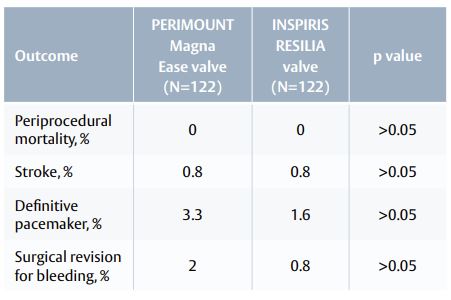
Haemodynamic performance
- At 1 and 3 years, the differences in mean pressure gradient, Vmax or LVEDV (Figure 1) with the INSPIRIS RESILIA valve vs the Magna Ease valve did not reach statistical significance. Mean gradients and peak velocity was also similar between groups across different valve sizes (19–21 mm, 23–25 mm and 27–29 mm).
- At 3 years, there was no reports of structural valve deterioration in the INSPIRIS RESILIA valves; four cases were reported in the PERIMOUNT Magna Ease valve, with 2 patients experiencing moderate–severe aortic stenosis and two patients reporting moderate–severe regurgitation.
Conclusion
The safety and efficacy outcomes of the new INSPIRIS RESILIA valve in patients younger than 70 years were comparable to the excellent outcomes in the established PERIMOUNT Magna Ease valve. Both valves also showed stable and comparable haemodynamics at short- to mid-term follow-up. These results may even suggest improved long-term outcomes in younger patients receiving the INSPIRIS RESILIA valve, however, more studies are needed to establish the potential advantages of this valve.
This document is a summary of the Francica A et al. presentation and covers key information including aim, type of study, methods, results and conclusions.
The full publication is available at:
Abbreviations:

Figure 1. LVEDV at (A) Year 1 and (B) Year 3

No clinical data are available that evaluate the long term impact of RESILIA tissue in patients.
Medical device for professional use. For a listing of indications, contraindications, precautions, warnings, and potential adverse events, please refer to the Instructions for Use (consult eifu.edwards.com where applicable).
Edwards, Edwards Lifesciences, the stylized E logo, Carpentier-Edwards, Carpentier-Edwards PERIMOUNT, Carpentier-Edwards PERIMOUNT Magna Ease, INSPIRIS, INSPIRIS RESILIA, Magna, Magna Ease, PERI, PERIMOUNT, PERIMOUNT Magna and RESILIA are trademarks or service marks of Edwards Lifesciences Corporation. All other trademarks are the property of their respective owners.
© 2022 Edwards Lifesciences Corporation. All rights reserved. PP–EU-5308 v1.0
Edwards Lifesciences • Route de l’Etraz 70, 1260 Nyon, Switzerland • edwards.com
D’Onofrio A, Cibin G, Lorenzoni G, Tessari C, Luzi G, Manzan E, Gerosa G and the INTU-ITA and RES-ITA Investigators.
Presented at 36th European Association for Cardio-Thoracic Surgery Annual Meeting, 2022.
Key points:
- All three valves demonstrated excellent haemodynamic outcomes with no differences in major postoperative complications.
- Operative times were lowest with the EDWARDS INTUITY valve; new pacemaker implantation was least common in patients receiving an INSPIRIS RESILIA valve.
- The EDWARDS INTUITY valve and the INSPIRIS RESILIA valve resulted in similar postoperative aortic gradients that were significantly lower than in patients with a Carpentier-Edwards PERIMOUNT Magna Ease valve.
Background information
- Several different aortic valve bioprostheses with different design characteristics and haemodynamic properties are available
- Options include conventional stented (CS), new-generation stented (NGS) and rapid deployment (RD) valves.
Aims
- To evaluate early clinical and haemodynamic outcomes of CS, NGS and RD aortic valve bioprostheses.
Type of study
- Multicentre, retrospective, observational study, with a propensity score weighting approach, that merged data from the INTU-ITA and the RES-ITA registry.
Endpoints
- Outcomes included operative times, postoperative complication rates and haemodynamic function.
Methods
- The study enrolled patients from 27 cardiac surgery centres who underwent surgical aortic valve replacement for aortic valve stenosis between January 2017 and December 2020 and received either a PERIMOUNT Magna Ease valve (CS), an INSPIRIS RESILIA valve (NGS) or an EDWARDS INTUITY (RD) valve.
Results
Study Population
- The study included 2,589 patients.
- Across the three groups, mean age was 72 (64–78) years, 40% patients were female and average body surface area was 1.83 (1.69–1.96) m2. Mean STS score was 1.66 (1.08–2.58) and 89% patients were in NYHA class >II.
- For the three-arm comparison, the EDWARDS INTUITY arm was chosen as the reference, with comparisons adjusted for factors including age, gender, comorbidities, STS score, NYHA and cardiac history.
- Most patients (65%, n=1,688) received an EDWARDS INTUITY valve; 605 (23%, n=605) received an INSPIRIS RESILIA valve and 296 (12%, n=296) a PERIMOUNT Magna Ease valve.
- INSPIRIS RESILIA was implanted in younger patients (Mean age: INSPIRIS RESILIA 60 [53–65] years; PERIMOUNT Magna Ease 72 [66–76] years; EDWARDS INTUITY 75 [66–76] years) with lower risk scores (STS score (%): INSPIRIS RESILIA 0.95 [0.65–1.52]; PERIMOUNT Magna Ease 1.3 [0.95–2.08]; EDWARDS INTUITY 1.9 [1.32–2.82])
Operative times
- The EDWARDS INTUITY valve allowed for shorter procedural times than the other bioprostheses (Table 1).
Table 1. Median operative times

Postoperative complications
- All three study groups had a device success rate of 96%.
- The incidence of major postoperative complications was similar across all study groups.
- New pacemaker implantations were significantly less frequent in the INSPIRIS RESILIA valve group (rate of 2%) than in the other study arms (6% in both the EDWARDS INTUITY valve and PERIMOUNT Magna Ease valve group).
Haemodynamic function
- Haemodynamic outcomes were better with the EDWARDS INTUITY valve compared with the PERIMOUNT Magna Ease valve, whereas there was no difference between the INSPIRIS RESILIA valve and EDWARDS INTUITY (Figure 1).
Figure 1. Postoperative mean aortic gradient.
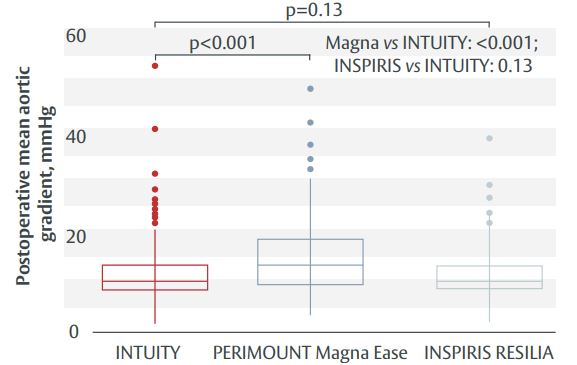
Conclusion
All three bioprostheses gave excellent haemodynamic and clinical outcomes, with significantly lower gradients with EDWARDS INTUITY valve vs PERIMOUNT Magna Ease valve. There was no difference in gradients between EDWARDS INTUITY and INSPIRIS RESILIA valves. Operative times were shortest with the EDWARDS INTUITY valve and the incidence of pacemaker implantation lowest among patients with INSPIRIS RESILIA valve. The rate of major postoperative complications was similar across all three study groups.
This document is a summary of the D’Onofrio A et al. presentation and covers key information including aim, type of study, methods, results, limitations and conclusions.
The full publication is available at:
Abbreviations:
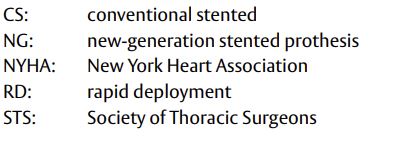
No clinical data are available that evaluate the long-term impact of RESILIA tissue in patients.
Important safety information:
Use of the EDWARDS INTUITY Elite valve system may be associated with new or worsened conduction disturbances, which may require a permanent cardiac pacemaker implant (PPI). The rate of PPI for the EDWARDS INTUITY Elite valve is within the range reported in the literature for various rapid deployment valves, but higher than that reported for surgical aortic valves. Physicians should assess the benefits and risks of the EDWARDS INTUITY Elite valve prior to implantation. See instructions for use for additional information.
Medical device for professional use. For a listing of indications, contraindications, precautions, warnings, and potential adverse events, please refer to the Instructions for Use (consult eifu.edwards.com where applicable).
Edwards, Edwards Lifesciences, the stylized E logo, Carpentier-Edwards, Carpentier-Edwards PERIMOUNT, Carpentier-Edwards PERIMOUNT Magna Ease, EDWARDS INTUITY, EDWARDS INTUITY Elite, INSPIRIS, INSPIRIS RESILIA, Magna, Magna Ease, PERI,
PERIMOUNT, PERIMOUNT Magna and RESILIA are trademarks or service marks of Edwards Lifesciences Corporation. All other trademarks are the property of their respective owners.
© 2022 Edwards Lifesciences Corporation. All rights reserved. PP–EU-5309 v1.0
Edwards Lifesciences • Route de l’Etraz 70, 1260 Nyon, Switzerland • edwards.com
Cibin G, D’Onofrio A, Lombardi V, Bergonzoni E, Italiano E, Gastino E, Evangelista G, Cao I and Gerosa G.
Presented at 36th European Association for Cardio-Thoracic Surgery Annual Meeting, 2022.
Key points:
- In patients with a small aortic annulus, the EDWARDS INTUITY valve was associated with reduced implantation times and improved haemodynamic results compared with implantation of the Carpentier-Edwards PERIMOUNT Magna Ease valve.
- Perioperative outcomes, survival and rehospitalisation rates were similar for both devices.
Background information
- Rapid deployment aortic bioprostheses (RDBs) have been developed to reduce operating times and allow for minimally invasive procedures.
- RDBs have shown excellent performance in haemodynamics studies.
Aims
- To compare early and medium-term outcomes for RBDs versus conventional stented valves in patients with small aortic annulus.
Type of study
- A retrospective single-centre study.
Endpoints
- Endpoints included operating times, haemodynamics, mortality and rehospitalisation.
Methods
- The study included patients who underwent isolated or combined surgical aortic valve replacement with a size 19 or 21mm EDWARDS INTUITY valve (RDB) or PERIMOUNT Magna Ease (conventional stented) valve.
- Propensity score matching was used to control for baseline differences between study groups.
- Follow-up visits were either scheduled on-site examinations that included echocardiography, or telephone interviews.
Results
Patients
- The study considered 666 patients, 220 of whom were included in the propensity-score matched analysis population.
- Of these 220 patients, 115 (52%) received an EDWARDS INTUITY valve and 105 (48%) received a PERIMOUNT Magna Ease valve (Table 1).
- The median follow-up time was 755 days.
Operating times
- The EDWARDS INTUITY valve was associated with significantly reduced cardiopulmonary bypass time vs the PERIMOUNT Magna Ease valve (median [95% CI]: 104 [76–129] min vs 132 [109–180] min; p<0.001).
- The aortic cross-clamp time was also significantly shorter with the EDWARDS INTUITY valve than with the PERIMOUNT Magna Ease valve (74 [54–98] min vs 100 [86–134] min; p<0.001).
Table 1. Baseline characteristics in the propensity-score matched population.

Haemodynamics
- Patients with an EDWARDS INTUITY valve had better haemodynamic outcomes than patients with a PERIMOUNT Magna Ease valve (Table 2).
Table 2. Haemodynamics
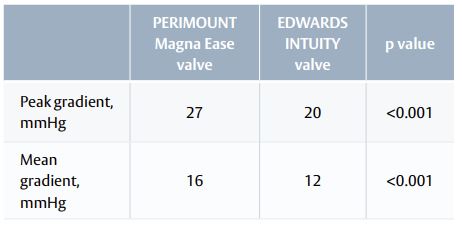
Survival and rehospitalisation
- Survival and rehospitalisation rates were similar across both study groups (p=0.761 and p=0.570, respectively).
- Adverse events outcomes were also similar, except for the occurrence of moderate prosthesis-patient mismatch (PPM; Table 3).
Conclusion
- In patients with a small aortic annulus, the EDWARDS INTUITY valve allowed for shorter operating times and improved haemodynamic function versus the PERIMOUNT Magna Ease valve. Perioperative outcomes, medium-term survival and rehospitalisation rates were similar across study groups.
Table 3. Adverse events with the EDWARDS INTUITY valve vs the PERIMOUNT Magna Ease valve.
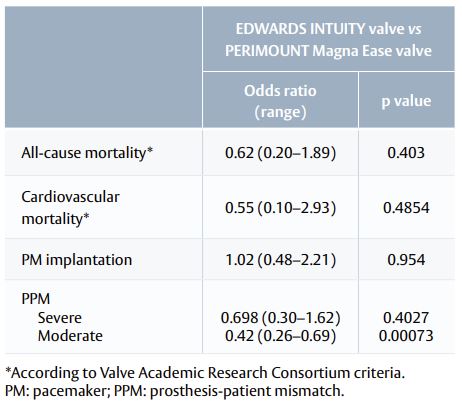
This document is a summary of the Cibin G et al. presentation, as presented at the EACTS congress, and covers key information including aim, type of study, methods, results, limitations and conclusions.
The full publication is available at:
Abbreviations

Important safety information: Use of the EDWARDS INTUITY Elite valve system may be associated with new or worsened conduction disturbances, which may require a permanent cardiac pacemaker implant (PPI). The rate of PPI for the EDWARDS INTUITY Elite valve is within the range reported in the literature for various rapid deployment valves, but higher than that reported for surgical aortic valves. Physicians should assess the benefits and risks of the EDWARDS INTUITY Elite valve prior to implantation. See instructions for use for additional information.
For professional use. For a listing of indications, contraindications, precautions, warnings, and potential adverse events, please refer to the Instructions for Use (consult eifu.edwards.com where applicable).
Edwards devices placed on the European market meeting the essential requirements referred to in Article 3 of the Medical Device Directive 93/42/EEC bear the CE marking of conformity.
Edwards, Edwards Lifesciences, the stylized E logo, and EDWARDS INTUITY are trademarks or service marks of Edwards Lifesciences Corporation or its affiliates. All other trademarks are the property of their respective owners.
© 2022 Edwards Lifesciences Corporation. All rights reserved. PP–EU-3975 v1.0
Edwards Lifesciences • Route de l’Etraz 70, 1260 Nyon, Switzerland • edwards.com
Anselmi A, D’alessandro G, Tomasi J, Aymami M, Mancini J, Corbineau H, Flécher E, Verhoye J-P.
Presented at 36th European Association for Cardio-Thoracic Surgery Annual Meeting, 2022.
Key points:
- The Carpentier-Edwards PERIMOUNT Magna Ease valve had a low rate of structural valve deterioration (SVD) throughout over a decade of follow-up.
- Haemodynamic outcomes were stable over time.
Background information
The PERIMOUNT Magna Ease valve has been available for use in aortic valve replacement surgery since the late 2000s.1
Several studies have assessed the early and medium-term performance of the PERIMOUNT Magna Ease valve, but only limited data on long-term outcomes are available.2
However, the number of relatively young patients receiving biological valves is increasing, thus creating a need for long-term data on bioprostheses.
Aims
- To evaluate the long-term durability and clinical performance of the PERIMOUNT Magna Ease valve.
Type of study
- A single-centre study with systematic follow-up.
Endpoints
- Endpoints included overall survival, echocardiographic results, and freedom from SVD, reinterventions for SVD, or valve-related death.
Methods
- The study included all comers who underwent surgical aortic valve replacement with the PERIMOUNT Magna Ease valve between 2008 and 2014.
- In-hospital data were collected prospectively.
- Patients were subject to systematic follow-up, including echocardiographic examinations.
- Valve-related adverse events were defined as SVD, non-structural valve dysfunction, infectious prosthetic endocarditis or prosthesis-patient mismatch.
Results
Patients
- The study included 1,017 patients with a mean age of 4 years ± 9.5; 59.6% of patients had calcified aortic stenosis and 11.9% had bicuspid morphology.
- The majority of procedures were elective (95.1% vs 4.9% non-elective procedures) and 34.1% of patients underwent concomitant procedures.
- A total of 975 patients entered follow-up (median follow-up: 8 years; follow-up completeness: 100%), 57.9% (n=565) of whom survived.
- The median follow-up time among survivors was 9 years (95% confidence interval 0.2–13.4).
Table 1. SVD and SVD-related reinterventions (Kaplan–Meier analysis).

Survival
- Overall survival was 8% after 10 years and 43.2% after 12 years.
- Twenty valve-related deaths occurred during follow-up.
- Freedom from valve-related death was 8% after 10 years and 96.9% after 12 years.
SVD
- The number of SVD events was 28 after 6.9 ± 3.3 years of follow-up (Table 1).
- The number of valve-related reinterventions was 31 after 8 ± 2.9 years.
Haemodynamics performance
- Haemodynamic performance was stable from discharge to last available follow-up (Table 2).
Table 2. Haemodynamics function at discharge and last follow-up.
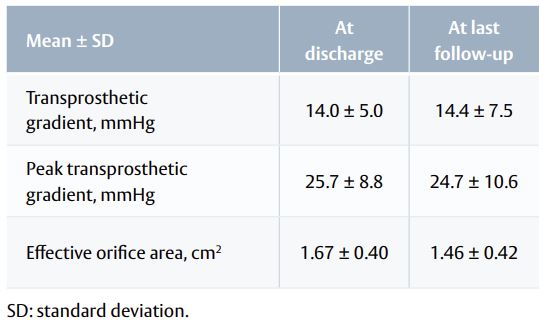
Conclusion
The PERIMOUNT Magna Ease valve showed optimal and maintained haemodynamic performance with good durability and limited other valve-related adverse events for up to 12 years after implantation. There is a need for studies with longer follow-up periods, because many patients receiving bioprostheses have a life expectancy longer than 12 years.
References
- Edwards Edwards Lifesciences receives FDA approval for new heart valve. Press release, 08 May 2009. Available at: https://www.edwards.com/ns20090508. [Accessed October 2020].
- Mayr B, Burri M, Vitanova K et al. Serial echocardiographic evaluation of the Perimount Magna Ease J Thorac Dis. 2021; 13: 4104-13.
This document is a summary of the Anselmi A et al. presentation, as presented at the EACTS congress, and covers key information including aim, type of study, methods, results, limitations and conclusions.
The full publication is available at:
Abbreviation

Medical device for professional use. For a listing of indications, contraindications, precautions, warnings, and potential adverse events, please refer to the Instructions for Use (consult eifu.edwards.com where applicable).
Edwards, Edwards Lifesciences, the stylized E logo, Carpentier-Edwards, Carpentier-Edwards PERIMOUNT, Carpentier-Edwards PERIMOUNT Magna Ease, Magna, Magna Ease, PERI, PERIMOUNT and PERIMOUNT Magna are trademarks or service marks of Edwards Lifesciences Corporation. All other trademarks are the property of their respective owners.
© 2022 Edwards Lifesciences Corporation. All rights reserved. PP–EU-5313 v1.0
Edwards Lifesciences • Route de l’Etraz 70, 1260 Nyon, Switzerland • edwards.com
Dr. Thourani
Edwards Lifesciences at EACTS 2022: Aortic valve disease: Patient centric management in elderly population
Prof. Anselmi
Edwards Lifesciences at EACTS 2022: Aortic valve disease: Patient centric management in elderly population
Prof. Siepe
Edwards Lifesciences at EACTS 2022: Aortic valve disease: Patient centric management in elderly population
Prof. Kalavrouziotis
Edwards Lifesciences at EACTS 2022: State of the art in the treatment of aortic valve regurgitation in young patients
Prof. Thomas Senage
Edwards Lifesciences at EACTS 2022: State of the art in the treatment of aortic valve regurgitation in young patients
Prof. Ruggero De Paulis
Edwards Lifesciences at EACTS 2022: State of the art in the treatment of aortic valve regurgitation in young patients
Prof. Doenst
Edwards Lifesciences at EACTS 2022: State of the art in the treatment of aortic valve regurgitation in young patients
Insights from INDURE registry
Prof. Ruggero De Paulis
Prof. D’Onofrio – EACTS 2021





